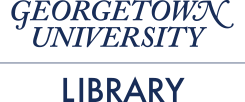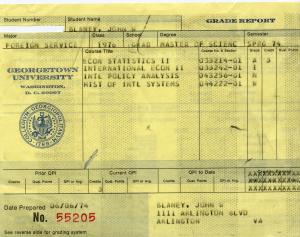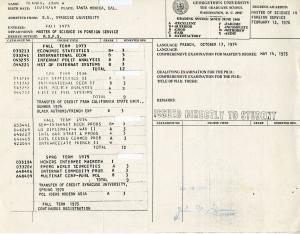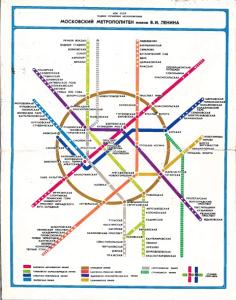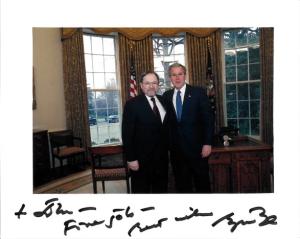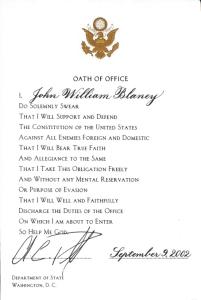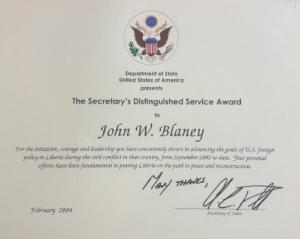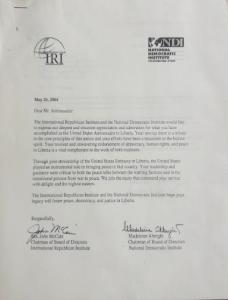Ambassador John W. Blaney is best known for his actions contributing to the end of the Second Liberian Civil War–most notably, his crossing of “No Man’s Land” to deliver a truce negotiation agreement to the forces of Liberian President Charles Taylor. His career did not start there, however; it began in the military, then continued in the Georgetown School of Foreign Service (Class of 1975). He was a leading diplomat in Moscow during the fall of the Soviet Union, and became close friends with President Nelson Mandela while stationed on a diplomatic mission in South Africa. After two decades of a successful, and trying, career in the Foreign Service, Blaney accepted the United States Ambassador role for Liberia. This exhibition showcases and celebrates some of Blaney’s key achievements and moments throughout his career.
Time at Georgetown
Ambassador Blaney attended Georgetown University's School of Foreign Service in the 1970s, often crediting it as his kickstart into diplomacy. On display are two documents from his time there: his Foreign Service Major grade report from Spring 1974 and his Master of Science in foreign service degree transcript.
Foreign Service Major Grade report, Spring 1974
Ambassador Blaney's School of Foreign Service grade report from the spring of 1974.
Master of Science in Foreign Service degree transcript, February 13th, 1976
Ambassador Blaney's completed degree transcript. Features the finished grades of the Spring report earlier in the exhibition.
A Career in Moscow
When interviewed, Blaney stated that his greatest career achievement was what he accomplished in Moscow in the 1980s–authoring "The U.S.-USSR Nuclear Risk Reduction Centers Agreement", the first nuclear arms control agreement of the Reagan administration of the 1980s, which was crucial to navigating disarmament and peace between the United States and the Soviet Union. On display are the seating arrangements for the Nuclear Risk Reduction Center agreement negotiations in Geneva, Switzerland, a “gag gift” created by Blaney's staff congratulating him for his skills in negotiation and achievements authoring the final proposal, and his Moscow driver’s license and public transit map.
The Art of Negotiating scrapbook "gag gift"
Gift from the Moscow Embassy staff after successful disarmament negotiations. The Art of Negotiation is heavily edited with news clippings covering the talks.
John W. Blaney Papers Box 1, Folder 15, GTM-20230821
Nuclear Disarmament Seating Arrangements
The United States nuclear disarmament negotiation seating arrangement. The blank side is where the Soviet Union delegation sat.
John W. Blaney Papers Box 1, Folder 15, GTM-20230821
Moscow Driver’s License and Public Transit Map
The first included image is a scan of Ambassador Blaney's Moscow driver's license and photo. The second included image is a public transit map of Moscow.
John W. Blaney Papers Box 12, GTM-20230821
Pre-Liberia Preparations
When Blaney was appointed the ambassadorship of Liberia, he was sworn into office by Secretary of State Colin Powell and President George W. Bush. Shown here is a signed photograph of Blaney and President Bush, as well as his Oath of Office card (2002). The inscription reads: “To John–Fine job–Best wishes, George Bush.” Attached is a note that reads “With the compliments of the President.”
POTUS Bush and Ambassador Blaney with POTUS’ signature and inscription
From 2004, a photograph of Ambassador John Blaney and former President Bush. The inscription reads "To John- Fine job- Best wishes, George Bush."
John W. Blaney Papers Box 5, Folder 2, GTM-20230821
Oath of Office card
Ambassador Blaney's oath of office card, September 9, 2002.
John W. Blaney Papers Box 5, Folder 10, GTM-20230821
Our Man in Libera
Blaney's most well known achievement is his battlefield negotiation of a ceasefire truce during the Second Liberian Civil War. He was honored in Liberia and at home for his actions during the war, as he was instrumental in initiating negotiations and peace talks. The photograph featured on the front page of the New York Post shows Blaney delivering the ceasefire agreement to the combatants besieging Monrovia (2003). Also included is an honorary doctorate from the United Methodist University in Monrovia and a school of Foreign Service alumni newsletter with Blaney on the front page (2003).
MSFS Alumniae Newsletter with Ambassador Blaney on the front page
Georgetown University's Masters School of Foreign Service alumni newsletter highlighting the accomplishments of the school's alumni. Ambassador Blaney is featured on the front page.
John W. Blaney Papers Box 5, Folder 5, GTM-20230821
New York Post front page featuring Blaney
The New York Post front page of Ambassador Blaney crossing No Man's Land to deliver peace negotiation papers to the forces besieging Monrovia.
John W. Blaney Papers Box 13, Folder 1, GTM-20230821
Honorary Doctorate from the United Methodist University in Monrovia
In 2003, the United Methodist University of Monrovia offered Ambassador Blaney an honorary PhD for his actions in Liberia during the war.
John W. Blaney Papers, Box 15, GTM-20230821
Coming Home
Blaney was recognized by Secretary of State Colin Powell with the Secretary's Distinguished Service Award for his service in Liberia (2004). He also received many letters of thanks from prominent politicians (one of several pictured here, from Madeleine Albright and John McCain, 2004). Blaney retired from the Foreign Service after serving in Liberia, but he remains active as a consultant and educator in diplomacy.
Secretary’s Distinguished Service Award
Ambassador Blaney earned the Secretary's Distinguished Service Award in 2003 for his actions in Liberia.
John W. Blaney Papers Box 13, Folder 4, GTM-20230821
Letter of Thanks from Madeleine Albright and John McCain
Ambassador Blaney's work in Liberia earned him accolades and thanks from many public figures. This 2004 bipartisan letter of thanks from John McCain and Madeleine Albright is an example of such.
John W. Blaney Papers Box 8, Folder 13, GTM-20230821
Vehicle flag from Liberia conflict
The flag in this case was the one flown on Ambassador Blaney's car in Monrovia during the siege.
John W. Blaney Papers, Box 15, GTM-20230821
Beyond the Exhibition
Ambassador John W. Blaney donated a variety of materials to Georgetown University's Booth Family Special Collections Center, much of which was unable to be shown in this exhibition due to its "snapshot" nature. Included in the collection are audio recordings (notably, a speech given in Russian at Moscow University and press conference recording from just before the Soviet Union collapse), realia (like bullets from Liberia and the Ambassador's briefcase from Moscow), and additional photographs and documents. More information on these materials can be found in the Finding Aid for the collection, which can be accessed in person by contacting Booth staff.
